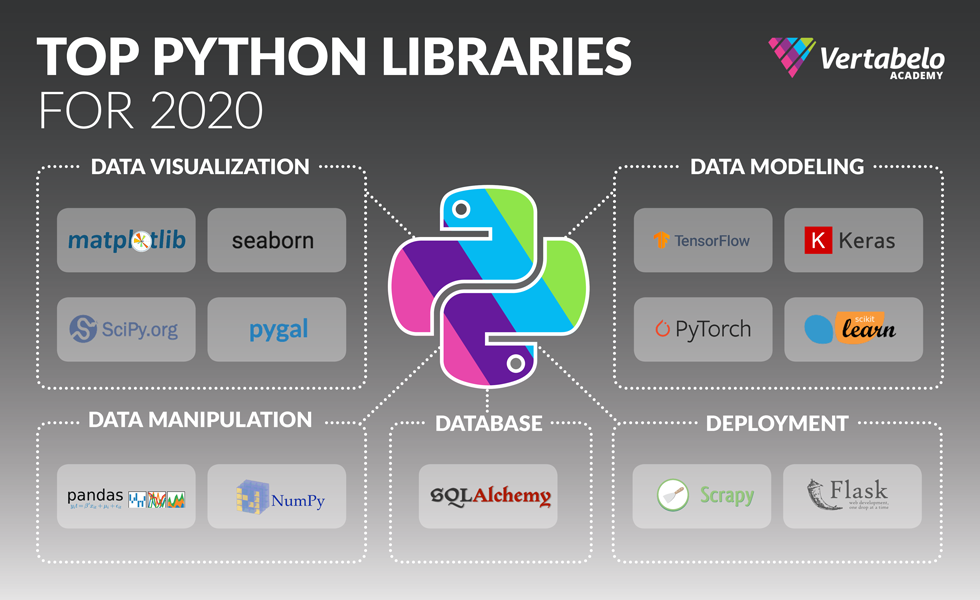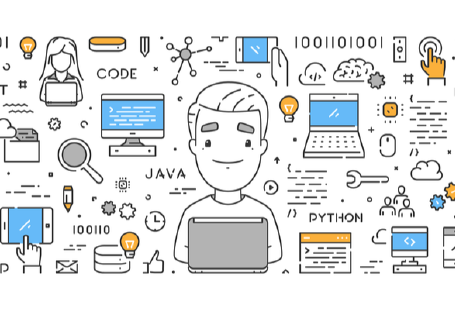13 Top Python Libraries You Should Know in 2020

Python provides a lot of libraries to help developers with their work. Which of them will be the most popular in 2020? And which are worth your time? Here are our picks for the 13 top Python libraries.
Python is one of the most popular programming languages. Many developers choose Python because it’s easy to learn and good for varied tasks, including data science, machine learning, data analysis and visualization, and web or desktop app development. The reason Python can be used in so many different types of programming is its large number of libraries. Which of these libraries should you choose? In this article, we present 2020’s most useful Python libraries for the fields of data manipulation, data visualization, databases, deployment, and data modeling.
Top 2 Python Data Manipulation Libraries
1. Pandas

The open-source Pandas library is one of the most popular choices for data analysis and data manipulation in Python. If you’re planning a career as a data scientist or data analyst and work with Python, this very important tool is worth learning.
Pandas provides high-performing data structures that make working with data easy, fast, and intuitive. The library’s primary data structures – series (one-dimensional) and DataFrame (two-dimensional) – are used very often in finance, statistical computing, social science, and engineering.
What special features does Pandas offer?
- Facilitating the cleaning, transforming and analyzing of data.
- Importing data from various file formats.
- Easily overcoming missing data.
- Deleting and inserting columns of data in a dataframe.
- Flexible group-by functionality.
- Easily converting data into other structures.
- Intelligent label-based slicing, indexing, and subsetting.
- Intuitive merging, joining, reshaping, and pivoting of data sets.
Pandas is used in conjunction with other libraries, such as NumPy, SciPy, and Matplotlib. To learn more about how to use this library, check out our Introduction to Python for Data Science.
Learn more about Pandas on its official website.
2. NumPy

NumPy (‘Numeric Python’) is another useful Python library and one that’s fundamental for scientific computing. It is an open-source tool designed for efficient numerical computing. NumPy provides high-performance multidimensional arrays and matrices and the tools to operate on them. It also contains helpful functions for linear algebra, Fourier transform, and random numbers.
NumPy integrates with a variety of databases. To learn more about this library, see the official NumPy website.
Top 4 Python Data Visualization Libraries
1. SciPy

SciPy is an open-source library designed for scientific computing. It contains functions that facilitate linear algebra, integration, image processing, and optimization. It is a good tool for a wide variety of scientific, mathematical, and engineering tasks that require some manipulation of numbers.
SciPy depends on NumPy. Find out more on the official SciPy website.
2. Matplotlib

Matplotlib is the most popular open-source library for data visualization. It can generate many types of plots – including bar charts, scatter plots, and histograms – with just a few lines of code.
This library also delivers an API for embedding plots into applications. Matplotlib allows programmers to visualize huge amounts of data and produce high-quality images in a range of formats. You can learn more about using this library in our Introduction to Python for Data Science.
For more about Matplotlib, visit the official site.
3. Pygal

Pygal is designed for creating vector graphics, mainly on websites. It allows users to make attractive, interactive charts in a fairly simple way. It is specifically designed to create Scalable Vector Graphics (SVGs), which integrate well with Python frameworks like Flask or Django. Pygal also allows you to save files in the PNG format with the CairoSVG converter.
Check out Pygal's official website to learn more.
4. Seaborn

Seaborn is an open-source library that’s designed for data visualization. This library is based on Matplotlib, but it gives users an easier and simpler way to create complicated plots. Seaborn has a lot of built-in styles, which means you can change the look of charts very quickly. (It also integrates well with Pandas data structures.) Seaborn provides automatic estimation and plotting of linear regression models.
Learn more about Seaborn here.
Top Two Python Deployment Libraries
1. Scrapy

Scrapy is an open-source Python framework that’s designed for crawling websites and extracting their data. These tasks are simple and fast with Scrapy; it’s also easy to plug in new functionality to this framework. Thanks to this flexibility, Scrapy can also be used for data mining, automated testing, and information processing.
Visit Scrapy.org to learn more.
2. Flask

Flask is another very popular Python framework. It is used in deploying data science models. This open-source tool is lightweight and designed to deploy complex applications easily and quickly. Since it is a microframework, it does not require particular libraries or tools. And you can add more functionality by way of its many extensions.
You’ll find more about Flask on its official website.
Top Python Database Library
SQLAlchemy

SQLAlchemy is open source and one of the most useful Python libraries. It provides an object-relational mapper that allows for mapping classes to a database. With SQLAlchemy, you can do efficient, high-performing work with databases and automate redundant tasks. There is a reason why SQLAlchemy has become a popular object-relational mapping tool among Python developers.
To learn more, go to the official SQLAlchemy website.
Top 4 Python Data Modeling Libraries
1. TensorFlow

Another one of the most useful Python libraries is TensorFlow. It is open source and designed for dataflow, machine learning, and neural network projects. It helps developers build and deploy machine learning applications easily and quickly and provides a very intuitive high-level API for building and training models. You can deploy models in the Cloud, in a browser or on a device. TensorFlow’s simple and flexible architecture makes it a good tool for researchers, as it allows them to move from idea to code to publication quickly. TensorFlow improves the workflow for preprocessing data, and building, training, and estimating the accuracy of models.
To learn more, go to TensorFlow.org.
2. PyTorch

PyTorch is a popular open-source framework for machine learning and deep learning. It’s a good tool for building and training neural networks. It optimizes tensors for deep learning using CPUs and GPUs, and it also accelerates the path from research to prototyping to production deployment.
Learn more about PyTorch on the official website.
3. Scikit-learn

Scikit-learn is a good open-source library for machine learning newbies and pros. It supports Support Vector Machines, KNN Maps, KNN classifiers, and regression algorithms. It’s an effective tool for predictive data analysis, statistical modeling, classification, and clustering. This is also a good choice for small projects.
Learn more at Scikit-Learn.org
4. Keras

Keras is another of the most popular Python libraries. This open-source deep learning library allows users to build prototypes quickly and create neural network projects. It also includes algorithms for the normalization, optimizer, and activation layers. This user-friendly, extensible tool enables easier development of deep learning models. It is a good, helpful tool for beginners, too, and can run seamlessly on CPUs and GPUs.
Find out more on the official Keras website.
Ready to Learn More About Python Libraries?
These 13 top python libraries are only a small percentage of the enormous number of Python libraries dedicated to various business areas. This vast number of specialist tools is one of the reasons Python is so popular. If you want to learn more about Python (a very valuable skill, and one that employers love) consider Vertabelo Academy’s Python training courses. If you’re a complete rookie, start with Python Basics Part 1 or Introduction to Python for Data Science. Or commit to the total Python learning path and go from a beginner to an advanced Python programmer.







